2015 Peugeot Partner bonnet
[x] Cancel search: bonnetPage 129 of 292
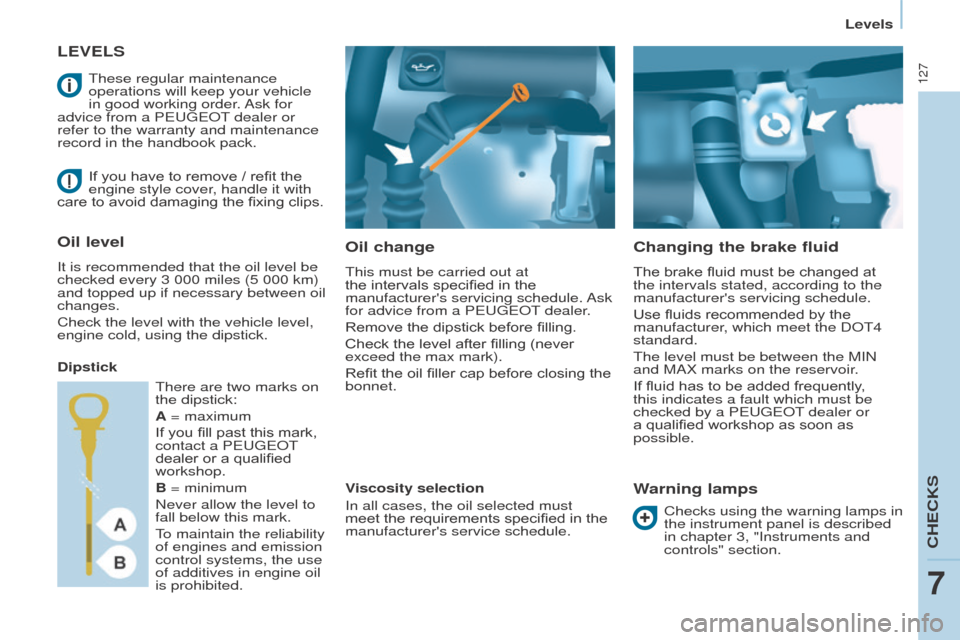
127
Partner-2-VU_en_Chap07_Verification_ed01-2015
LEVELS
Oil change
This must be carried out at
the intervals specified in the
manufacturer's servicing schedule. Ask
for advice from a PEUGEOT dealer.
Remove the dipstick before filling.
Check the level after filling (never
exceed the max mark).
Refit the oil filler cap before closing the
bonnet.
Changing the brake fluid
The brake fluid must be changed at
the intervals stated, according to the
manufacturer's servicing schedule.
Use fluids recommended by the
manufacturer, which meet the DOT4
standard.
The level must be between the MIN
and MAX marks on the reservoir.
If fluid has to be added frequently,
this indicates a fault which must be
checked by a PEUGEOT dealer or
a qualified workshop as soon as
possible.
Warning lamps
If you have to remove / refit the
engine style cover, handle it with
care to avoid damaging the fixing clips.
Oil level
It is recommended that the oil level be
checked every 3 000 miles (5 000 km)
and topped up if necessary between oil
changes.
Check the level with the vehicle level,
engine cold, using the dipstick.
Dipstick
Viscosity selection
In all cases, the oil selected must
meet the requirements specified in the
manufacturer's service schedule.
These regular maintenance
operations will keep your vehicle
in good working order. Ask for
advice from a PEUGEOT dealer or
refer to the warranty and maintenance
record in the handbook pack.
Checks using the warning lamps in
the instrument panel is described
in chapter 3, "Instruments and
controls" section.
There are two marks on
the dipstick:
A = maximum
If you fill past this mark,
contact a PEUGEOT
dealer or a qualified
workshop.
B = minimum
Never allow the level to
fall below this mark.
To maintain the reliability
of engines and emission
control systems, the use
of additives in engine oil
is prohibited.
Levels
CHECKS
7
Page 134 of 292

DIESEL
132
Partner-2-VU_en_Chap07_Verification_ed01-2015
FUEL CUT- OFF
The flashing of this warning
lamp is accompanied by a
message in the screen.
Check that there is no odour or
leakage of fuel outside the vehicle and
re-establish the fuel supply:
-
switch of
f the ignition (STOP
position),
-
remove the key
,
-
put the key back in the ignition,
-
switch on the ignition and start.
DIESEL PRIMING PUMP
Refer to chapter 7, "Under the
bonnet" section.
Fuel used for Diesel engines
The Diesel engines are compatible with
biofuels which conform to current and
future European standards (Diesel fuel
which complies with standard EN 590
mixed with a biofuel which complies
with standard EN 14214) available at
the pumps (containing up to 7 % Fatty
Acid Methyl Ester).
B30 biofuel can be used in certain
Diesel engines. However, this use,
even occasional, requires strict
application of the special servicing
conditions. Contact a PEUGEOT
dealer or a qualified workshop.
The use of any other type of (bio)
fuel (vegetable or animal oils, pure
or diluted, domestic fuel...) is strictly
prohibited (risk of damage to the
engine and fuel system). If you should run out of fuel, it is
necessary to prime the fuel circuit.
-
Fill the fuel tank with at least five
litres of Diesel.
-
Squeeze and release the manual
priming pump, under the bonnet
under the protective cover
.
-
Operate the starter until the engine
starts.
In a serious collision, a mechanism
automatically prevents fuel from
reaching the engine.
Fuel
Page 151 of 292
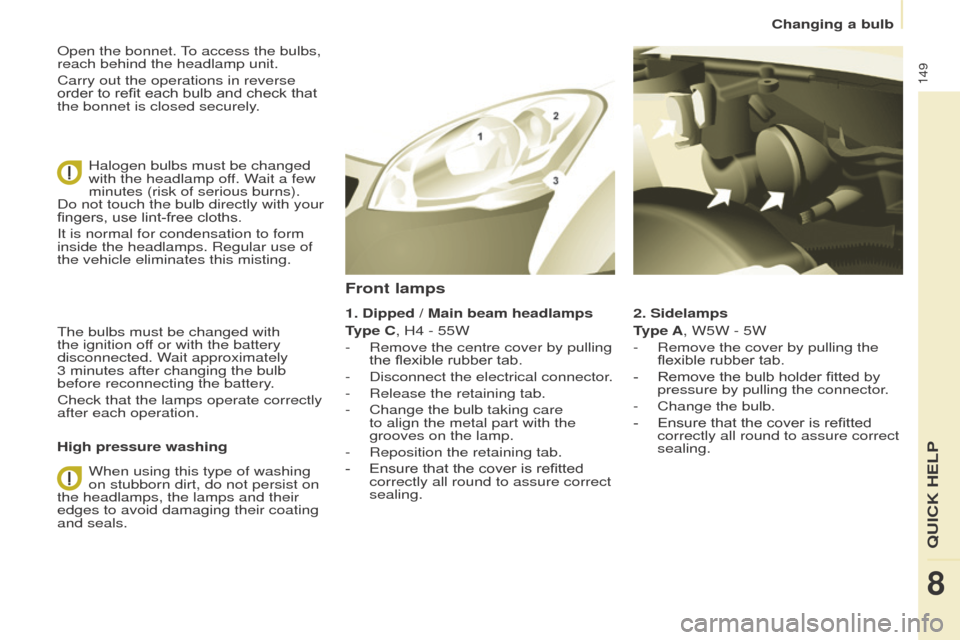
149
Partner-2-VU_en_Chap08_Aide-rapide_ed01-2015
Open the bonnet. To access the bulbs,
reach behind the headlamp unit.
Carry out the operations in reverse
order to refit each bulb and check that
the bonnet is closed securely.Halogen bulbs must be changed
with the headlamp off. Wait a few
minutes (risk of serious burns).
Do not touch the bulb directly with your
fingers, use lint-free cloths.
It is normal for condensation to form
inside the headlamps. Regular use of
the vehicle eliminates this misting.
The bulbs must be changed with
the ignition off or with the battery
disconnected. Wait approximately
3
minutes after changing the bulb
before reconnecting the battery.
Check that the lamps operate correctly
after each operation.
High pressure washing
When using this type of washing
on stubborn dirt, do not persist on
the headlamps, the lamps and their
edges to avoid damaging their coating
and seals. 2. Sidelamps
Type A, W5W - 5W
-
Remove the cover by pullin
g the
flexible rubber tab.
-
Remove the bulb holder fitted by
pressure by pullin
g the connector.
-
Change the bulb.
-
Ensure that the cover is refitted
correctly all round to assure correct
sealing.
Front lamps
1. Dipped / Main beam headlamps
T ype C, H4 - 55W
-
Remove the centre cover by pullin
g
the flexible rubber tab.
-
Disconnect the electrical connector
.
-
Release the retaining tab.
-
Change the bulb taking care
to align the metal part with the
grooves on the lamp.
-
Reposition the retaining tab.
-
Ensure that the cover is refitted
correctly all round to assure correct
sealing.
Changing a bulb
QUICK HELP
8
Page 156 of 292
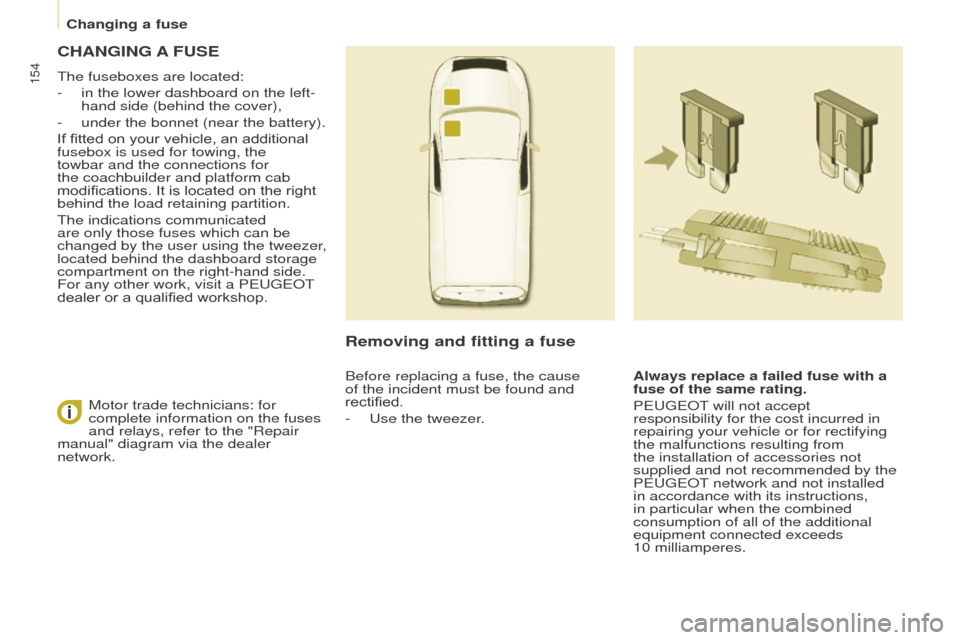
154
Partner-2-VU_en_Chap08_Aide-rapide_ed01-2015
CHANGING A FUSE
The fuseboxes are located:
-
in the lower dashboard on the left-
hand side (behind the cover),
-
under the bonnet (near the battery).
If fitted on your vehicle, an additional
fusebox is used for towing, the
towbar and the connections for
the coachbuilder and platform cab
modifications. It is located on the right
behind the load retaining partition.
The indications communicated
are only those fuses which can be
changed by the user using the tweezer
,
located behind the dashboard storage
compartment on the right-hand side.
For any other work, visit a PEUGEOT
dealer or a qualified workshop.
Removing and fitting a fuse
Always replace a failed fuse with a
fuse of the same rating.
PEUGEOT will not accept
responsibility for the cost incurred in
repairing your vehicle or for rectifying
the malfunctions resulting from
the installation of accessories not
supplied and not recommended by the
PEUGEOT network and not installed
in accordance with its instructions,
in particular when the combined
consumption of all of the additional
equipment connected exceeds
10
milliamperes.
Motor trade technicians: for
complete information on the fuses
and relays, refer to the "Repair
manual" diagram via the dealer
network. Before replacing a fuse, the cause
of the incident must be found and
rectified.
-
Use the tweezer
.
Changing a fuse
Page 159 of 292
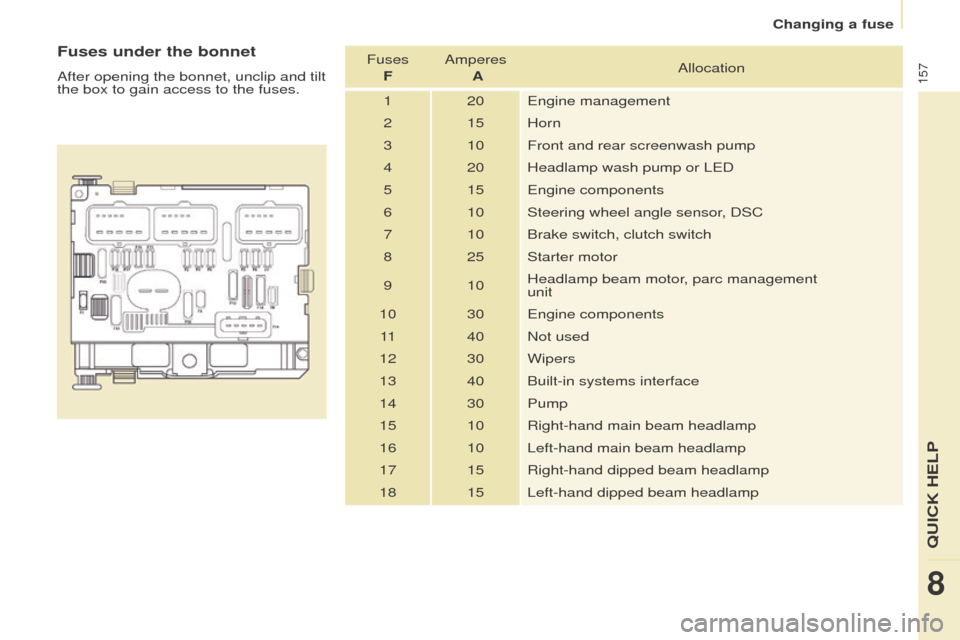
157
Partner-2-VU_en_Chap08_Aide-rapide_ed01-2015
Fuses under the bonnet
After opening the bonnet, unclip and tilt
the box to gain access to the fuses.Fuses
F Amperes
A Allocation
1 20 Engine management
2 15 Horn
3 10 Front and rear screenwash pump
4 20 Headlamp wash pump or LED
5 15 Engine components
6 10 Steering wheel angle sensor, DSC
7 10 Brake switch, clutch switch
8 25 Starter motor
9 10 Headlamp beam motor, parc management
unit
10 30 Engine components 11 40 Not used
12 30 Wipers
13 40 Built-in systems interface
14 30 Pump
15 10 Right-hand main beam headlamp
16 10 Left-hand main beam headlamp
17 15 Right-hand dipped beam headlamp
18 15 Left-hand dipped beam headlamp
Changing a fuse
QUICK HELP
8
Page 282 of 292

24
In the event of an accident or impact
under the vehicle or to one of the
charging fl aps
In the event of an accident or an
impact to the underbody of the vehicle
(for example: contact with a milestone,
a raised kerb or other urban roadside
fi xture) or in the event of an impact,
even slight, to one of the charging
fl aps, these circumstances may
have serious repercussions for your
vehicle's electrical system or traction
battery and cause damage to them.
Have your vehicle checked as soon as
possible by a franchised dealer or a
qualifi ed workshop.
Never touch the "300 Volt" components
of the orange cables exposed and
visible inside or outside of the vehicle.
In the case of serious damage to the
traction battery:
- do not try to do anything to the
vehicle yourself,
- never touch liquids coming from
the traction battery and in the event
of contact between your body and
these products, wash abundantly
with water and contact a doctor as
soon as possible.
For washing the bodywork, do
not use a pressure greater than
80 bar.
In the event of exposure to a fi re
In the event of exposure to a fi re,
leave and have everybody leave the
vehicle immediately. Never intervene
yourself (risk of electrocution). You
must contact the emergency services
immediately. Warn them that your
vehicle is electric.
Audible environment
Outside
The driver should be particularly
vigilant when driving the electric
vehicle, as it makes very little noise
when moving.
Inside
While it is operating you may hear
noises that are specifi c to an electric
vehicle, such as:
- the traction battery relays when
starting,
- the vacuum pump when braking,
- tyre or wind noise from the vehicle
when driving.
When parking on a slope, it is
recommended that you apply the
parking brake before placing the drive
selector at P
. When moving off, o
knock may be felt, which is normal.
Washing precautions
Never wash the vehicle while the
battery is on charge.
Before washing the vehicle, check
that the access fl aps are closed and
the cover on each charging socket is
closed.
In order to avoid damaging the electric
units, the use of a high pressure jet
wash is strictly forbidden:
- under the bonnet,
- under the vehicle, around the
battery packs.
Long term
When your vehicle is to be laid up
for an indeterminate period, carry out
a complete recharge of the traction
battery every three months (following
the normal charging procedure). Before
carrying out the charging operation,
ensure that the 12 V ancillaries battery
is not disconnected or discharged. If
this is the case, refer to the "Ancillaries
battery" section for information on
connecting or charging it.
Laying up the vehicle
Precautions to take when
charging the battery
- Do not stay inside or near the
vehicle.
Particularly if you wear a pacemaker
or other medial electric device.
For complete information on the
precautions to take, contact your
doctor.
- Never do any work under the
bonnet as there is a risk of serious
injury.
Risk of cuts as the fan may start
turning at any time. Risk of burns
as some areas remain very hot for
even an hour after the end of the the
charging operation.
Page 283 of 292
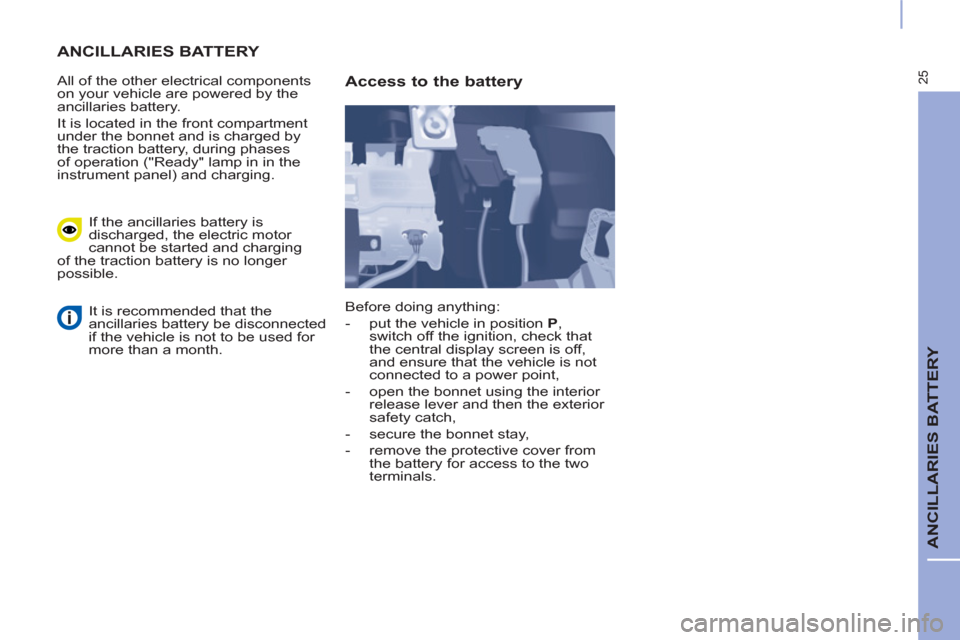
25
ANCILLARIES BATTERY
ANCILLARIES BATTERY
All of the other electrical components
on your vehicle are powered by the
ancillaries battery.
It is located in the front compartment
under the bonnet and is charged by
the traction battery, during phases
of operation ("Ready" lamp in in the
instrument panel) and charging.
If the ancillaries battery is
discharged, the electric motor
cannot be started and charging
of the traction battery is no longer
possible.
It is recommended that the
ancillaries battery be disconnected
if the vehicle is not to be used for
more than a month. Before doing anything:
- put the vehicle in position P
,
switch off the ignition, check that
the central display screen is off,
and ensure that the vehicle is not
connected to a power point,
- open the bonnet using the interior
release lever and then the exterior
safety catch,
- secure the bonnet stay,
- remove the protective cover from
the battery for access to the two
terminals.
Access to the battery
Page 287 of 292
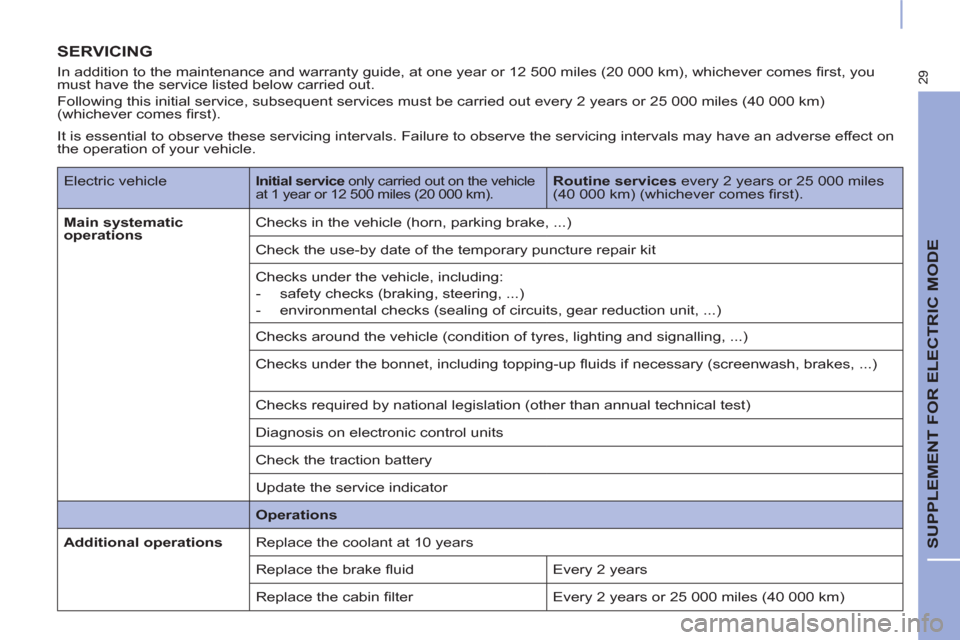
29
SUPPLEMENT FOR ELECTRIC MODE
SERVICING
In addition to the maintenance and warranty guide, at one year or 12 500 miles (20 000 km), whichever comes fi rst, you
must have the service listed below carried out.
Following this initial service, subsequent services must be carried out every 2 years or 25 000 miles (40 000 km)
(whichever comes fi rst).
Electric vehicle
Initial service
only carried out on the vehicle
at 1 year or 12 500 miles (20 000 km).
Routine services
every 2 years or 25 000 miles
(40 000 km) (whichever comes fi rst).
Main systematic
operations
Checks in the vehicle (horn, parking brake, ...)
Check the use-by date of the temporary puncture repair kit
Checks under the vehicle, including:
- safety checks (braking, steering, ...)
- environmental checks (sealing of circuits, gear reduction unit, ...)
Checks around the vehicle (condition of tyres, lighting and signalling, ...)
Checks under the bonnet, including topping-up fl uids if necessary (screenwash, brakes, ...)
Checks required by national legislation (other than annual technical test)
Diagnosis on electronic control units
Check the traction battery
Update the service indicator
Operations
Additional operations
Replace the coolant at 10 years
Replace the brake fl uid Every 2 years
Replace the cabin fi lter Every 2 years or 25 000 miles (40 000 km)
It is essential to observe these servicing intervals. Failure to observe the servicing intervals may have an adverse effect on
the operation of your vehicle.